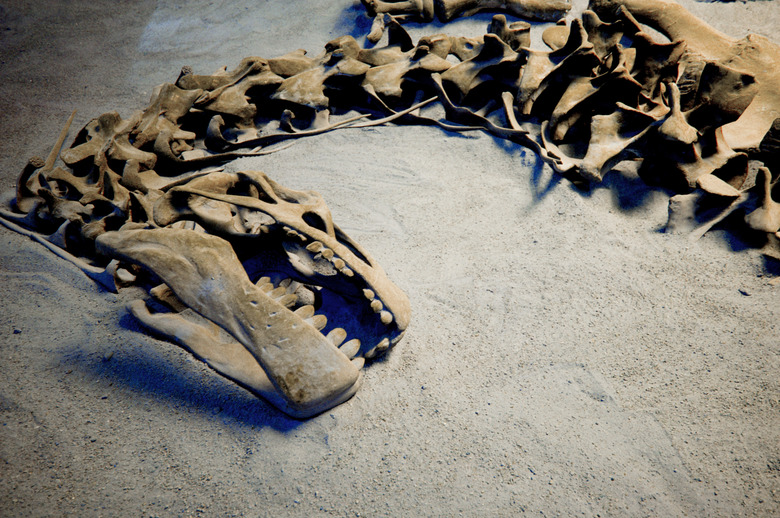What Was The Earth's Atmosphere Like About 200 Million Years Ago?
In the late Triassic, Earth experienced catastrophe on a scale without parallel in human history. About 200 million years ago, in just a brief heartbeat of geologic time, over half of all species on Earth vanished forever. Scientists have long tried to understand how so many species could have perished so quickly.
Modern research has tied the late-Triassic mass extinction to some strange but devastating changes in Earth's atmosphere that took place at about the same time.
In this post, we're going over some of the potential causes of the atmospheric conditions and exactly what the atmosphere was like during this time.
Causes
Causes
It's not entirely certain why Earth's atmosphere changed dramatically 200 million years ago. Scientists believe a series of large volcanic eruptions about 201 million years ago were the cause.
These eruptions left huge lava flows along the edges of the North Atlantic and released a lot of CO2 into the atmosphere. Huge quantities of this greenhouse gas triggered global warming, which in turn melted ice that contained trapped methane and led to further warming.
Increasing CO2 concentrations would also have made the oceans more acidic, another possible cause of the mass extinction.
Another theory of the drastic changes in the Earth's atmosphere at that time was an explosion of methane in the deepest areas of the sea floor. This caused gigatons of methane to flood the environment, which could've lead to drastic climate and atmospheric change (we'll go more into this theory later).
Oxygen
Oxygen
Earth's atmosphere at the end of the Triassic contained the same kinds of gases it does today — nitrogen, oxygen, carbon dioxide, water vapor, methane, argon and other gases in trace amounts. The concentrations of some of these gases, however, was very different.
In particular, Late-Triassic air contained the lowest oxygen levels in more than 500 million years. Less oxygen made it more difficult for animals to grow and reproduce and restricted their habitats. Higher elevations became uninhabitable because the oxygen concentrations at high altitude were even lower than those at sea level, too low for most animal species to tolerate.
After this time period, oxygen levels gradually increased, which allowed for the species and organisms that we're familiar with to evolve and develop. It's believed that right after 200 million years ago, large groups of ocean dwelling creatures called diatoms drastically increased the oxygen levels in the atmosphere.
Carbon Dioxide
Carbon Dioxide
However, carbon dioxide concentrations were even more important. Scientists estimate two- or three-fold increases of carbon dioxide levels over a relatively short period of geologic time. Eventually, they reached levels roughly four times the concentrations observed today.
Carbon dioxide is a greenhouse gas; it can act like a blanket, trapping heat in the atmosphere, so Earth stays warmer than it would be otherwise. A rapid increase in CO2 concentrations could have caused major changes in Earth's climate, which might have brought about the mass extinction.
Methane
Methane
As CO2 levels jumped, rising temperatures could have melted methane-bearing seafloor ice deposits. The melted ice probably released large amounts of methane into the atmosphere over a relatively short period. Methane is an even more potent greenhouse gas than CO2.
Studies by scientists at Utrecht University suggest that methane levels rose rapidly 200 million years ago. Overall, some 12 trillion tons of carbon in the form of either carbon dioxide or methane were released in less than 30,000 years.
The Utrecht University researchers believe these rapid changes in the atmosphere probably brought about massive and rapid climate change which in turn may have led to the mass extinction.
References
- UC Berkeley: The Triassic Period
- UC Berkeley: The Jurassic Period
- Science: Did Greenhouse Gases Unleash the Dinosaurs?
- https://www.zmescience.com/research/studies/200-million-years-ago-half-of-all-life-on-earth-went-extint-from-a-methane-eruption/
- https://www.sciencemag.org/news/2005/09/breathing-easier-jurassic
Cite This Article
MLA
Brennan, John. "What Was The Earth's Atmosphere Like About 200 Million Years Ago?" sciencing.com, https://www.sciencing.com/earths-atmosphere-like-200-million-years-ago-4871/. 22 May 2019.
APA
Brennan, John. (2019, May 22). What Was The Earth's Atmosphere Like About 200 Million Years Ago?. sciencing.com. Retrieved from https://www.sciencing.com/earths-atmosphere-like-200-million-years-ago-4871/
Chicago
Brennan, John. What Was The Earth's Atmosphere Like About 200 Million Years Ago? last modified August 30, 2022. https://www.sciencing.com/earths-atmosphere-like-200-million-years-ago-4871/
